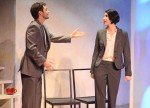Sleek maple floors and spotless white walls – the fictional exhibit is in pristine condition, awaiting the crowds who will soon marvel at the artwork on display. However, for some, serenity is mundane.
Breaking the facade of this docile environment, UCLA’s theater production of “Eat the Runt” contrasts the stillness of this art museum set by exposing the harassment, devastation and manipulation hidden beneath the freshly glossed flooring.
Beginning today and lasting until March 16 at UCLA’s Little Theater in Macgowan Hall, graduate actors from the School of Theater, Film and Television present “Eat the Runt,” a satirical representation of office politics. The production casts actors into roles that address sexism, racism and identity – forcing attendees to face their own preconceptions and judgments.
“We as a people judge,” said Shirley Jo Finney, director and professor in the School of Theater, Film and Television. “Somebody walks into a room and you’re already judging them by what they wear, what color skin they have, what they look like.”
UCLA graduate theater student Alex Oberheide said unlike traditional narratives with conflict-resolution structures, “Eat the Runt” is set in an art museum, a docile environment that amplifies the psychological destruction that comes along with workplace harassment.
Finney said “Eat the Runt” comments on how the most qualified applicants do not always get the job. She said the production follows the character, Chris, as he plots to turn the art museum upside down, to expose the manipulation its darker side.
The plot divulges the ruthlessness that emerges as people claw their way to the top of the bureaucratic hierarchy. However, because males are cast into female roles and vice versa, Finney said the production breaks down the barriers of gender and sexuality.
“The dialogue is very indicative – more feminine or more masculine. So when we have a guy playing (a woman’s role), automatically he is assumed to be gay,” Oberheide said.
Not only do actors play characters across genders, but some characters are also played by both genders during different shows. The actors each learned two roles, so Oberheide said each performance will have a different dynamic based on whether characters are played by female or male actors.
Graduate theater student Philicia Saunders said power relationships are portrayed differently when she plays the character, New Merit, than when her male peer, Evan, acts out the same role.
“When I’m playing New Merit, I’m more intimidated by the director of the board,” Saunders said. “But when Evan plays (that role) he can push back because it’s two males (pitted) against each other.”
The production’s casting comments on the social constraints of gender, but Finney said that it also deconstructs racial stereotypes. Just as females are cast into male roles, a white woman plays a black role.
“We have a white girl talking about being black. (The audience) really has to suspend their disbelief and ride the wave with us,” Oberheide said.
Finney said she does not expect the audience to grasp the concepts of gender and racially neutral roles right away, but when it clicks, it will force them to evaluate their preconceived prejudices.
“That’s the beauty of theater,” Oberheide said. “You can cast colorblind. You can bend the rules of gender and transsexuals.”
Even though the production addresses serious topics plaguing the workplace, Finney said the audience will not drown in the heavy subject matter. Instead, they will be visually stimulated by the elaborate set and situational satire.
Set in an art museum, the Little Theater stage is transformed with white slate walls that double as projection screens for artwork.
“We’ve got visual eye candy,” Finney said. “But the moving projections are part of a contemporary modern setting to heighten our surreal world and comment on racism and prejudice.”
The art captivates the eye, but Saunders said it is just as mentally stimulating as it is visually captivating.
In addition to the art, Oberheide said the play incorporates other performing arts to invigorate the audience’s senses and build a stronger, more cohesive message. He said the 80-minute production encapsulates song, dance, quotes and mythology.
“I like to think of it like Baskin-Robbins’ 31 flavors,” Oberheide said. “You get a taste test of everything and you’re not going home disappointed.”
